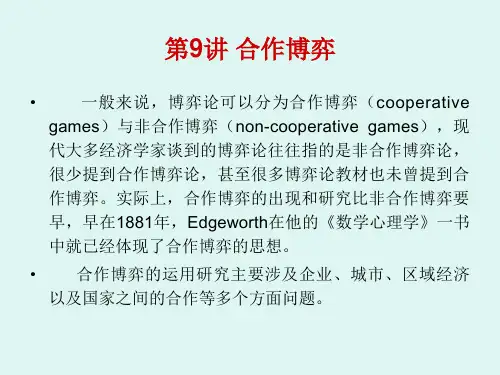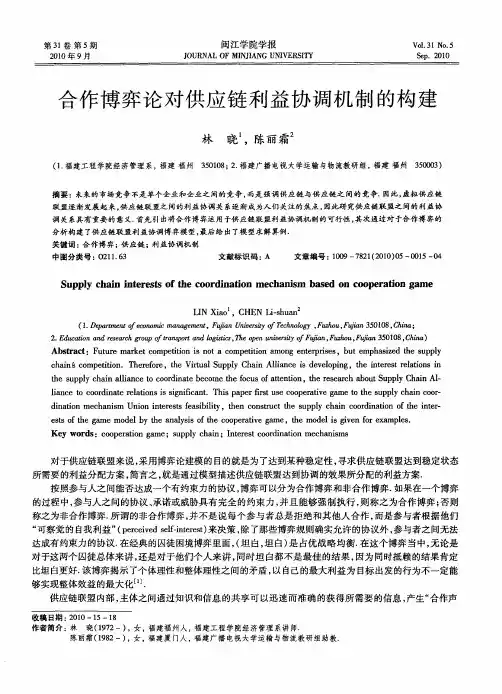第16章 合作博弈论
- 格式:pdf
- 大小:387.73 KB
- 文档页数:27


经济学中的博弈论与合作博弈论是经济学中的一门重要理论,旨在研究个体之间的互动和决策行为。
而合作则是博弈论中的重要概念,指的是个体为了实现共同利益而进行的合作行为。
本文将介绍经济学中的博弈论与合作的相关概念和应用。
一、博弈论的基本原理博弈论是研究冲突和合作的数学模型,可以描述个体之间的策略选择和收益分配。
博弈论的基本原理包括以下几个方面:1. 策略与收益:在博弈过程中,个体根据不同的策略做出决策,并根据决策结果获得相应的收益或损失。
2. 纳什均衡:纳什均衡是博弈论中的重要概念,指的是在一个策略组合下,没有个体能够通过单方面改变策略而获得更高的收益。
3. 合作与背叛:博弈论中存在合作与背叛两种策略。
合作是指个体在博弈过程中相互合作,共同实现最大化利益;而背叛则是指个体追求个人利益,不考虑其他个体的利益。
二、博弈论在经济学中的应用博弈论广泛应用于经济学中的各个领域,包括市场竞争、价格战略、合作和博弈等方面。
1. 市场竞争:博弈论可以描述市场中企业之间的竞争行为。
例如,在寡头市场中,几个大型企业之间的竞争就可以使用博弈论来分析,以确定每一个企业采取的最优策略。
2. 价格战略:在市场竞争中,企业之间常常会进行价格战略的博弈。
博弈论可以帮助企业分析竞争对手的策略,从而制定出最优的价格策略。
3. 合作与合作:博弈论中的合作是一种重要的策略选择。
在经济学中,个体通过合作可以获得更好的收益。
例如,合作联盟可以帮助企业降低成本、提高市场份额。
4. 交易谈判:在经济交易中,买家和卖家之间的谈判过程也可以使用博弈论进行分析。
通过博弈论的工具,可以帮助确定最优的谈判策略,达成双方满意的交易结果。
5. 公共博弈:在公共事务中,个体之间的合作行为也是博弈论的研究领域。
例如,环境保护、资源分配等问题涉及到个体之间的合作与博弈,博弈论可以帮助制定出最优的决策方案。
三、博弈论与合作的局限性尽管博弈论和合作在经济学中具有重要的理论和实践价值,但也存在一些局限性。


合作与博弈论合作与博弈论是一门研究人类行为决策的学科,它涉及到多方参与者之间的合作与竞争。
通过分析各方为了追求个人利益或共同利益而做出的决策和行动,可以揭示出人类行为背后的动机和策略。
合作与博弈论在经济学、政治学、社会学等领域都发挥着重要的作用。
一、合作与博弈的基本概念合作与博弈论的起点是对“合作”和“竞争”的定义和理解。
合作指的是多方参与者之间为了追求个人或共同利益而进行的共同行动。
而竞争则强调各方参与者为了争夺有限的资源而进行的对抗性行为。
在博弈论中,博弈是指多方参与者在特定的决策环境中根据一定的规则做出选择的过程。
博弈可以分为合作博弈和非合作博弈。
合作博弈中,参与者可以通过讨论、协商等方式合作,以实现共同利益的最大化;非合作博弈则是各方参与者根据自身利益最大化来进行决策,忽视了其他参与者的存在。
二、合作与博弈的应用领域1. 经济学领域:合作与博弈理论对经济学的研究具有重要意义。
在市场竞争中,企业之间的合作与博弈行为会直接影响市场格局与资本流动。
此外,合作博弈还可以用于分析合资企业、产业联盟等经济合作形式。
2. 政治学领域:在政治决策中,不同政党、政府之间的合作与博弈决定了政策的制定和执行。
例如,国际社会中的合作与博弈关系决定了国与国之间的合作、竞争和冲突发展。
3. 社会学领域:社会中的个体行为也可以通过合作与博弈论来分析。
研究人们在社会环境中的合作、互助与竞争行为,有助于理解社会发展、社会关系和社会合作的规律。
三、合作与博弈策略分析在合作与博弈过程中,各方参与者会根据自身的利益和目标做出决策,以取得最优解。
合作与博弈存在一系列策略,包括合作、背叛、妥协等。
下面以“囚徒困境”为例,简要分析其中的合作与博弈策略。
囚徒困境是合作与博弈领域中最有名的案例之一。
假设有两名囚犯被关押在不同的牢房,检察官给他们提供了一个选择:如果其中一人背叛另一人,那个背叛者将被减刑,而被背叛者将面临更长的刑期。
如果两人都背叛,那么他们将都被判刑5年;如果两人都合作,那么他们将面临较轻的指控,只被判刑1年。

博弈论中合作的定义博弈论,作为现代数学的一个重要分支,也是运筹学的一个重要学科。
它主要研究在公式化的激励结构间的相互作用,是一套研究具有竞争或斗争性质现象的数学理论和方法。
博弈论不仅在数学领域有着广泛的应用,还在经济学、政治学、社会学,乃至生物学等诸多领域都有着不可或缺的地位。
在博弈论的众多研究主题中,合作是一个核心概念,对于理解和预测个体或集体在特定环境下的策略选择至关重要。
合作,在博弈论中,通常指的是两个或多个参与者通过采取某种策略,使得他们的共同利益得到最大化,而不是仅仅追求个人利益的最大化。
这种合作可能是显性的,比如通过签订合同或协议来明确各方的权利和义务;也可能是隐性的,比如通过长期的重复博弈来建立起一种默契或信任。
在博弈论中,合作与非合作是两种基本的博弈类型。
非合作博弈强调的是个体理性,即每个参与者都独立地选择自己的策略,以最大化自己的利益。
而在合作博弈中,强调的是集体理性,即参与者们通过协商、妥协和联合行动,以达到对所有人都有利的结果。
这种合作可能涉及到资源的共享、风险的共担、信息的交换等多个方面。
合作博弈的一个典型例子是囚徒困境。
在这个经典的博弈模型中,两名嫌疑犯被分别关押,不能互相沟通。
如果两人都选择合作(即都不揭发对方),那么他们都会得到较轻的刑罚。
但是,如果其中一人选择背叛(即揭发对方),而另一人选择合作,那么背叛者将会得到无罪释放,而合作者将会受到重罚。
如果两人都选择背叛,那么他们都会受到中等的刑罚。
在这个博弈中,虽然从个体理性的角度来看,背叛似乎是一个更有吸引力的选择,但是从集体理性的角度来看,合作才是最优的策略。
合作博弈的另一个重要概念是纳什均衡。
纳什均衡指的是在博弈中,每个参与者的策略选择都是对其他参与者策略选择的最佳反应。
在合作博弈中,纳什均衡可能意味着参与者们通过合作达到了一种稳定的状态,其中任何一方都没有动机单方面改变自己的策略。
这种均衡状态可能是全局最优的,也可能是局部最优的,取决于具体的博弈结构和参与者的策略空间。


合作博弈理论在商业策略和合作伙伴关系的应用正文:第一章:引言在商业世界中,合作和竞争是并存的。
可是在合作中,各方需付出一定代价,同时也希望从合作中获得最大的利益。
这时候就需要使用博弈论中的合作博弈理论来分析商业策略和合作伙伴关系中的合作问题。
第二章:合作博弈理论概述合作博弈理论是博弈论中的一种,它的研究对象是多人合作博弈。
多人合作博弈中,参与者们通过合作来获取收益。
与此同时,他们也要面对参与者之间的冲突,因为他们都想最大限度地获得收益。
合作博弈理论为这种合作问题提供了解决方法。
合作博弈理论中的核心概念是合作稳定标准。
合作稳定标准是一个合作结果,其中所有参与者都认为这个结果对他们来说是最好的,既没有冲突也没有争议。
合作稳定标准是通过各参与方的利益交换来实现的。
第三章:商业策略中的合作博弈理论应用商业竞争环境中,企业之间常采用合作策略来获得更多的利益。
如上文提到的,利益的分配是参与者之间最大的问题,博弈论中的合作博弈理论可以很好地解决这一问题。
合作博弈理论中的均分收益(Nash Bargining Solution)解决方案,让各方都在合作中获得实际收益,从而让合作更加有效。
此外,合作博弈理论还能帮助企业分析合作伙伴筛选。
企业在进行合作时,如果不能判断潜在伙伴价值,将面临失误和损失。
但是合作博弈理论可定量分析每个伙伴的价值,避免企业与不合适的伙伴合作,并从更适合的伙伴中获得更多的利益。
第四章:合作伙伴关系中的合作博弈理论应用合作伙伴关系需要各方共同投入资源,才能实现最大效益。
然而,在收益分配和资源贡献方面,常常存在分歧,影响伙伴关系的质量。
合作博弈理论可以协助伙伴关系维系,避免立场的差异。
通过合作博弈,各方可以坦诚地沟通,采用公正合理的方式分配资源和收益权益,建立情感合理的合作伙伴关系。
对于长期合作的伙伴,特别重要。
此外,合作博弈理论可以解决合作伙伴退出合作的问题。
在合作伙伴关系中,如果一方退出了合作,将对整个关系造成严重影响。

合作型博弈论作文在这个充满竞争的世界里,你可能觉得不是你赢就是我输,就像在一场激烈的拔河比赛,两边都在拼尽全力往自己这边拽绳子。
但今天我想跟你唠唠一种不一样的“玩法”,那就是合作型博弈论。
咱先来说说啥是博弈论。
简单来讲,就是当不同的人或者团体在做决策的时候,会互相影响,就像下象棋,你走一步,我走一步,每一步都要考虑对方的反应。
而合作型博弈论呢,就像是大家商量好了一起下这盘棋,目标不是把对方整垮,而是共同走向胜利。
想象一下,有两个小商贩,一个卖煎饼,一个卖豆浆。
如果他们各干各的,煎饼摊的老板可能觉得只要自己的煎饼好吃就行,豆浆老板也只关心自己的豆浆够不够香浓。
但是呢,如果他们合作起来,那就不一样了。
煎饼摊老板可以对顾客说:“咱这儿的煎饼配上隔壁的豆浆,那叫一个绝!”豆浆老板也可以回应:“喝咱的豆浆,再去吃个旁边的煎饼,包您满意!”这样一来,原本可能各自只有10个顾客的小生意,通过合作就可能吸引到20个甚至更多的顾客。
这就是合作型博弈论在生活中的一个小例子,1 + 1可就大于2了。
在动物界也有这样的例子。
你看那些蜜獾和导蜜鸟,蜜獾这小子爱吃蜂蜜,但是它自己找蜂巢比较费劲。
导蜜鸟呢,知道蜂巢在哪,可它没有办法打开蜂巢吃到蜂蜜。
于是这俩家伙就达成了合作。
导蜜鸟找到蜂巢后,就带着蜜獾去,蜜獾用它强壮的爪子打开蜂巢,然后它们俩就可以共享美食了。
要是它们不合作,蜜獾得费老大力气找蜂巢,导蜜鸟只能眼巴巴看着蜂巢里的蜂蜜流口水。
再说说咱人类社会里的大事情。
在商业世界里,很多大公司也明白了合作型博弈论的妙处。
就比如说汽车制造商和电池制造商。
现在电动汽车越来越流行,汽车制造商想要造出好的电动汽车,就离不开性能优良的电池。
如果汽车制造商和电池制造商合作,他们就可以共同研发,提高电池的性能,降低成本。
汽车因为有了好电池可以卖得更好,电池制造商也因为有了汽车这个大市场而赚得盆满钵满。
这可比他们互相竞争,互相压价或者藏着掖着技术要好得多。

合作博弈论pdf
合作博弈论是一种博弈论的分支,与非合作博弈论不同,它着重于探讨参与者之间如何合作,以实现最优结果。
在这种博弈中,参与者可以通过合作获得更好的结果,比如增加收益或减少成本。
同时,博弈的参与者也需要考虑其他参与者的利益,以达成共同的目标。
在合作博弈中,参与者之间的合作可以采用不同的方法,如协商、合作协议或契约。
这些合作机制可以为参与者提供稳定的合作平台,并确保参与者之间的合作是公平和可持续的。
合作博弈论的应用非常广泛。
它在商业领域中被广泛运用,尤其是在国际贸易和投资合作中。
合作博弈还可用于资源共享和环境保护等问题,以及多个企业之间的合作和竞争问题。
总之,合作博弈理论为参与者之间的合作提供了一个框架。
在这种博弈中,参与者需要考虑他们自己的利益,同时也需要考虑其他参与者的利益,从而实现共同的目标。
这种协作方式可以为参与者带来更好的结果,同时还可以确保合作的公平和可持续性。


协商、合作共赢论协商博弈在现实生活中的应用摘要:在现实生活中,博弈几乎无处不在,博弈的结果也因人而异,对于一些博弈双方存在共同利益的博弈,双方可以通过协商,采取有利于双方的策略,从而最终实现双方利益最大化,也就是通过协作博弈实现了正和博弈。
关键词:博弈论协作博弈合作共赢当代凯恩斯主义的集大成者、经济学的最后一个通才——保罗·萨缪尔森曾说过:“要想在现代社会做一个有文化的人,你必须对博弈论有一个大致了解。
在今天这个尔虞我诈、竞争激烈的社会中,要想拥有一个美丽的人生,不付出汗水怎么行?不绞尽脑汁又怎么行!而我们绞尽脑汁思考的过程,其实就是博弈。
”在现实生活中,博弈几乎无处不在,例如:在游戏中,我们必须通过博弈来分出胜负;在购物时,我们不能确切地知道产品质量是否良好,要通过博弈才能作出选择;在恋爱中,我们要想确切地知道恋人爱自己有多深,也得通过博弈;在政治领域、军事领域,博弈都是帮助我们确切地判断对手实力的必需“工具"……由此可见,博弈是如此重要。
博弈有三个关键概念:正和博弈、零和博弈、以及负和博弈,但是对于一些博弈双方存在共同利益,有共同兴趣爱好的博弈,双方可以通过协商,采取有利于双方的策略,从而最终实现双方利益最大化,也就是通过协作博弈实现了正和博弈。
现实生活中也有很多通过协作博弈实现共赢的例子,假设宿舍中有甲、乙两个同学,他们各有两个选择的策略,上网娱乐或者学习。
若两人都学习,甲乙各有7各单位的收益若两人都选择上网娱乐,则甲乙各得到5各单位的收益若其中一人选择上网,另一人选择学习。
则因为相互干扰,学习的获得2各单位的效益,而上网的获得三个单位的效益如图所示:上网学习上网通过划线求解法可以得出,在甲乙两人上网与学习的博弈中没有优势策略,但是存在着最优反应,图表中得出共有四个最有反应。
针对这种没有优势策略的博弈而言,最好的解决方法就是通过协商解决,因为进行博弈的双方之间有共同的兴趣偏好,存在着共同利益,因此通过甲、乙双方的协商,建立一种合作关系,可以使学习和娱乐的效率大大提高,从而实现双方利益的最大化,即通过协商实现了双方的共赢。
Cooperative Game TheoryR.Chandrasekaran,Most of this follows Owen and Shubik and Wooldridge et al.When we extend two person game theory to consider n person games for n≥3,there is little difference from non-cooperative game theory point of view.Existence of Nash equilibrium follows from similar arguments and all the difficulties we had with two person nonzero sum games show up here as well.But there is a new phenomenon here that must be taken into account:—that of coalition formation.Subsets of players could form a"cartel"and act in unison to gain more than they could if they acted independently.This forms one essential aspect of the game here.And this requires having binding contracts,using correlated mixed strategies,and transferable utility(so that the gain could be shared between the colluders in some way that all agree to). The main study here is to model the coalition formation,and gain sharing process.So we abstract away details and concentrate on important parts of the game.Game Representation:Characteristic Function Forms Let N= {1,2,...,n}be the set of players.Any nonempty subset S of N is called a coalition.Definition1By a characteristic function of an n-person game we mean a function v that assigns a value to each subset of players;i.e v:2N→R. We think of v(S)as the payoffto the subset S of N if it acts in unison;some times it is also assumed that this is maximin payoffin that we also think all of N−S act in unison(against S).v(S)is called the value of the coalition S.When we go from games in extensive forms to normal forms,we abstract some details and only look at strategies to obtain a(mixed)equilibrium(for which we do not need the details that have been abstracted away).Similarly,1in n person cooperative games where the study focuses on stable coalition formations,we abstract away even further and look only at the characteristic function form.It is implicitly assumed that a coalition S can distribute its value v(S)to its members in any way they choose.Hence these are also called transferable utility games(TU games for short).How the distribution takes place is the main interest in these games.It is generally assume that v({φ})=0;v(S)≥0∀S⊆N.Outcomes/Solutions An outcome of a game in characteristic form con-sists of:(i)A partition of N into coalitions,called a coalition structure,and(ii)a payoffvector,whic distributes the value of each coalition to its members.A coalition structure CS over N is a nonempty collection of nonempty subsets CS={S1,S2,...,S k}satisfying the relations:∪k i=1S i=N;S i∩S j=φif i=jThe set of all coalition structures for a given set N of players is denoted by CS N.v(CS)denotes the sum k j=1v(S j).A vector x=(x1,x2,...,x n)is payoffvector for a coalition structure CS={S1,S2,...,S k},over N={1,2,...,n}ifx i≥0∀i∈Nx i≤v(S j)1≤j≤ki∈S jAn outcome is a apir[CS,x].x(S)= i∈S x i is called the payofffor the coalition S under x.x is said to be efficient in the outcome[CS,x]ifx i=v(S j)1≤j≤ki∈S jA payoffvector x for a coalition structure CS N is called an imputation if it is efficent and individually rational.x i≥v({i})∀i∈Nx i=v(S j)1≤j≤ki∈S j2The set of all imputations for a coalition structure CS∈CS N is denoted by E(CS).If CS={N},then this is denoted by E(N)or E(v).If a payoffvector is an imputation,then each player prefers this to being alone.Howver, a group of players may want to deviate since it might be better for them and this would result in unstable conditions.Subclasses of games in characteristic form:Monotone Games:A game[N,v]in characteristic form is monotone if[S⊆T]⇒v(S)≤v(T)Most games are montone;nonmonotonicuty may arise because some players intesely dislike each other or becuase of the overhead charges for communi-cation increase nonlinearly with size of the coaltion.Superadditive Games:A game[N,v]in characteristic form is said to be superadditive if[S∩T=φ]⇒v(S∪T)≥v(S)+v(T)It comes from the fact that S can assure itself v(S)without help from any one and so also T can assure itself v(T),then S∪T can assure itself the sum.Since we have assumed that characteristic function is nonnengative,it follows that superadditivity implies monotonicity.Most games are superadditive;indeed older books did not consider any others.Non-superadditive games arise from anit-trust or anti-monopoly regualtions.In superadditive games,there is no compelling reason for players to form any coalition structure except CS={N}called the"grand"coalition.Hence the outcome for such a game is of the form[N,x]wherex i=v(N)A non-superaddtive game cna be transformed into a superadditive game by the following process:Let T⊆N be any coalition.Let CS T denote all coalition structures over T.Given a game[N,v]we define a new game [N∗,v∗]byv∗(T)=maxv(CS)CS∈CS T3G∗is called the superadditive cover of the game G.v∗(T)is the maximum that the players in set T cna achive by forming their own coalition structure in G.Convex(Supermodualr)Games:A game is said to be convex or supermodular ifv(S∪T)+v(s∩T)≥v(S0+v(T)∀S,T⊆NTheorem2A game G=[N,v]is convex iff[T⊂S;i/∈S]⇒[v(S∪{i})−v(S)≥v(T∪{i})−v(T)]A convex game is superadditive.Definition3A game v in characteristic function form is called a constant sum game ifv(S)+v(N−S)=v(N)∀S⊆NIt is clear from the super-additivity condition that the maximum the entire set of players can get is v(N).Now we look into the questions of how to divide this total—it what does each player get—in a stable situation.Let (x1,x2,...,x n)denote the payoffto the players.Clearly no player will accept less than what he can get for himself with no help from others.Hence one condition that this vector must satisfy(called individual rationality)isx i≥v({i})∀iThe second condition that is normally imposed(known as pareto-optimality) is to requireni=1x i=v(N)Any vector that satisfies these two conditions is called an imputation.The main question now is which of these in the setE(v)={x:x i≥v({i});1≤i≤n;ni=1x i=v(N)}should the predicted outcome of this game be?The answer is easy in one case(this is the most uninteresting case!)4Definition4A game is said to be inessential if v(N)= n i=1v({i}). By superadditivity,we have v(N)≥ n i=1v({i}).If equality holds,E(v) contains only one point—x i=v({i})∀iHence this the outcome of such games.From now on,we are interested only in essential games where v(N)> n i=1v({i}).Definition5Let x,y∈E(v).We say that x dominates y via the coalition S[denoted by x≻S y]ifx i>y i∀i∈Sx i≤v(S)i∈SEach player in S gets more under x than in y and the coalition S has enough to give its members the amount specified in x.Definition6We say x dominates y if the above is true for some S.If x dominates y then y is not stable.Games with same domination structure are in some sense equivalent and we make this precise by:Definition7Two n-person games u and v are said to be isomorphic if there is a function f:E(u)→E(v)such that[x,y∈E(u);x≻S y]⇔[f(x)≻S f(y)]We are preserving the domination structure.Definition8Two n−person games u and v are S−equivalent if there exists numbers(a1,a2,...,a n)andβ>0such thatv(S)=βu(S)+ i∈S a i∀S⊆NTheorem9If u and v are S-equivalent,then they are isomorphic.The converse is true for all constant sum games.5e the function f(x)=βx+a.Since S-equivalence is indeed an equivalence relations,it is sufficient to study one member of each of its equivalence classes.Such representatives are called normalized games.Definition10An essential(characteristic function)game is said to be(0,1)-normalized ifv({i)}=0∀iv(N)=1Lemma11A game is S−equivalent to exactly one game in(0,1)normalized form.Another normalization used in the literature is the(−1,0)normalization wherev({i})=−1∀iv(N)=0We use the(0,1)normalization.Thus,the set of all(0,1)normalized games consist of v∈2N that satisfyv(φ)=0v({i})=0∀iv(N)=1[S∩T=φ]⇒v(S∪T)≥v(S)+v(T)If the game is also a constant sum game it satisfies the relationv(S)+v(N−S)=v(N)Any(n−1)−person game u in(0,1)normalization can be converted to an equivalent n-person constant sum game v in(0,1)normalization as follows:v(S)=u(S)1−u(N−S)if n/∈Sif n∈SHere N={1,2,...,n}.6Definition12A game v is symmetric if v(S)depends only on|S|.Definition13A game v in(0,1)normalization is called a simple game ifv(S)∈{0,1}∀SCoalitions S with v(S)=1are called winning coalitions and those with v(S)=0are called losing coalitions.Definition14Let(p1,p2,..,p n)be a nonnegative vector and let q satisfy therelation0<q<n i=1p iThe weighted majority game(q;p1,p2,...,p n)is defined as a simple game v in(0,1)normalization wherev(S)=1if i∈S p i≥qelseDefinition15The set of undominated imputations C(v)of a game v is called the core of a game.Theorem16C(v)is the set of n-vectors x satisfying the relations;i∈Sx i≥v(S)∀S⊆Nni=1x i=v(N)Proof.Clearly,thefirst condition implies the result thatx i≥v({i})∀iHence any vector that satisfies both relations above is an imputation.Suppose x satisfies both relations.Let y be an n-vector satisfying the relationy i>x i∀i∈S7for some S⊆N.Theni∈Sy i> i∈S x i≥v(S)Hence there is no vector y that dominates x.Hence vectors that satisfy both relations are undominated.Conversely,suppose we have an n-vector y that does not satisfy both re-lations.Ifni=1y i=v(N)then y is not an imputation and hence not in the core.Supposeni=1y i=v(N)i∈Sy i=v(S)−ǫfor someǫ>0and some nonempty set S⊂N.By superadditivity it follows thatα=v(N)−v(S)− i∈N−S v({i})≥0Let|S|=s;[note that0<s<n].Consider an n-vector z defined as follows:z i=y i+ǫv({i})+αn−sIt is easy to verify that z is an imputation and that z≻S y and hence y can not be in the core.This result shows that the core is a closed convex polyhedral set. Example1Player1(seller)has a horse which is of no value to him.There are two buyers#2,#3who want to buy the horse.#2has a value of$90 and#3has value of100for the horse.The characteristic function form for this game isv({i})=0∀iv({2,3})=0v({1,2})=90v({1,3})=v({1,2,3})=1008Hence the core consists of vectors x satisfying the relations:x1+x2≥90x1+x3≥100x1+x2+x3=100x i≥0∀iThe core for this game is given byC(v)={(t,0,100−t):90≤t≤100} Exercise17What is the non-cooperative solution to this game?9。